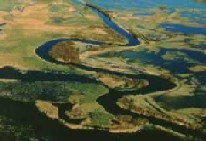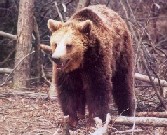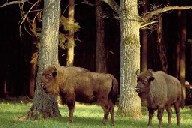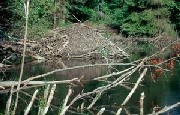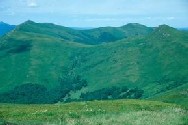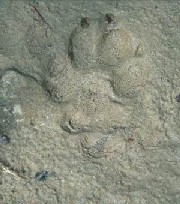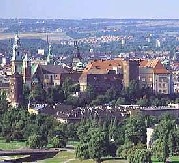The wildlife and primeval forests of Poland
“There. That is wolf”
“Where?” I asked stepping forward to get a better look.
“Under your foot,” Przemyslaw replied dryly. I still had a lot to learn about wolf tracking.
Notwithstanding my clumsiness I had learnt a great deal about wolves and wolf tracking in my short stay in Poland. It had been a steep learning curve for me as I knew next to nothing about Poland let alone wolves.
I arrived in Poland scantily prepared: the currency was zloty, Lech Walesea was from Gdansk and the Polish army had charged the German panzer tanks on horseback. Drudging my memory and browsing through guidebooks I discovered that I knew more than I thought. Chopin and Copernicus were both Polish, as is the Pope. But much of it, sadly, made depressing reading, not least the ghettos of Warsaw as portrayed in the ‘Pianist’ and the death camps, most notably Auschwitz. Some six million Poles died in World War II.
Yet in spite of such history and undiscovered jewels such as Krakow I had not come to enjoy Poland’s cultural heritage but rather its fascinating flora and fauna, in particular the forest of Bialoweiza and Bieszczady National Park. Impossible to pronounce (best attempted with a drunken Sean Connery accent), these two areas offer unique wildlife and landscapes within a couple of hours from the UK.
With jagged mountains, vast unspoiled beech forests and mountain meadows, the Bialoweiza Primeval Forest, straddling the Polish-Belarussian border, is the largest and best-preserved fragment of ancient European lowland forest and is home to many big ungulates like red deer, roe deer, wild boar and European bison. Yes that’s right bison, perhaps better associated with the plains of North America than the forests of Europe, bison once inhabited much of Europe but can now only be found in eastern Poland.
My guidebook intrigued me by describing Bialoweiza as a ‘primeval forest’ but what it failed to explain is what is a primeval forest? My imagination immediately conjured up Tolkeinesque images of somewhere that was dark, forbidding, the realm of trolls and other such evil spirits. The reality was very different in very fact much lighter than I had expected. This is in part due to the age of the forest – there is no uniformity, trees have not been planted at the same time, four hundred year old trees come crashing to the ground clearing great swathes of the forest.
Despite the light it was not easy to navigate and within minutes I was regretting my neglect of childhood fairy tales – Hansel would undoubtedly have come better prepared. Thankfully I did not have to pay too dearly for my schoolboy error - Andrez, my guide, pulled out his compass and smiled ruefully.
That was the last and only time that Andrez showed any sign of doubt. As a guide he was both informative and illuminating, his knowledge encyclopedeaic if a little earnest. He explained that a fifth of the biomass is deadwood, 120 cubic metres per hectare. The importance of this is not just pure statistics but rather the biodiversity and the life that this deadwood sustains. For Andrez the main value of such deadwood is the continuity of the natural process. He stressed again and again how everything was interconnected, continually emphasising the importance of the cycle. The deadwood gives rise to mushrooms, which in turn leads to an abundance of caterpillars. The caterpillars result in a high density of song birds but it is the raptors who do best of all as the caterpillars east all the leaves and hence there is little protection for the songbirds who are easy prey.
The biodiversity of a temperate zone such as that of Bialoweiza cannot compete with the biodiversity of the tropics, whether in quantitative or qualitative terms. The fungi and ungulates of Poland are not as ‘sexy’ as the headline-grabbing chimpanzees of Equatorial Africa and the tree frogs of Guyana. But this does not make the biodiversity of the temperate zone any less valuable. Although it might have less diversity to that of the tropics it is still irreplaceable – if we lose what little we have then there will be nothing left. Czeslaw Milosz, Poland’s Noble prize-winning poet, has compared the biodiversity of Bialoweiza to Castle Vavel, a historical monument and national treasure in Krakow. He says that denuding the forest and its slow destruction is like taking the castle apart brick by brick by brick.
I found myself won over by Andrez’s earnest message and intrigued by the minutiae of the forest. I was not so interested in seeing bison or hearing the rutting cry of red deer – much bigger than our roe deer – but it was the detail of Bialoweiza that fascinated and captivated me. Bialoweiza surprised me, but more than anything I surprised myself by how taken I was by fungi and deadwood, especially given the fact that I had given up biology at the age of twelve. I was curious to see whether Bieszczady would hold the same attraction.
Driving down to Bieszczady in the south-eastern corner of Poland I was struck by the contrast between city and countryside. Whilst Warsaw with its hip-hop bars is striving to break into the 21st century, the country is struggling to make it into the 20th century. A report from the United Nations telecoms agency ITU shows that only 0.03 percent of the Polish population has access to wide-band internet, putting the country in 63rd place worldwide, just behind Guam, Nicaragua, the Solomon Islands and Lebanon.
Much more tangibly there was a palpable lack of industry in the countryside, which seemed to be gripped by malaise and wearied by years of communism. This was perhaps unsurprising given that hundreds of thousands of people were forcibly moved during Soviet times to the countryside and hence they have little empathy or understanding of the countryside and traditional farming techniques. A sad dejected air permeated everything even the police and their attempts at curbing speeding motorists – a cardboard cut-out of a police car on the side of the road that would have been amusing had it not been quite so pathetic.
In contrast to the biomass of Bialoweiza, my time in Bieszczady was focused more on wildlife. Perhaps unsurprisingly given there was such an abundance of wildlife – I had not expected such a wealth and breadth of wildlife in Poland.
We started along a track at the back of the farm and I thought that Przemek was leading me up the garden path both metaphorically and literally. Thankfully I was wrong and as I was to discover there were signs of wildlife all around us that I was simply not aware of. “There has been a lot of rain,” I noted lamely of the flooded fields around us. “No it’s not rain but is flooded by beavers,” said Przemek as he led me over to a beaver dam, explaining that beavers use the dam not only as a means of defence but also as a larder in winter in which they store small logs on the bottom of the dam.
Minutes later we came across red deer tracks. “Where there are deer there will be wolves,” Przemek pronounced. He was not wrong and sure enough we found wolf tracks. On the other side of the path Przemek pointed out fox scat and the more dainty prints of the fox. He was in his element, focused on the path ahead, gleaning the muddy track for signs and information whilst giving me an impressive commentary of what he was finding. “Foxes defecate on the side of the path. To mark their territory.” “Wolf scat will often contain feathers or fur in it.” “A wolf steps in its own tracks.” “ Often one wolf walks on the path as the others walk alongside the path, sometimes in and amongst the trees.”
Soon we left the path and were trudging through the woods. A stream gurgled noisily at the bottom of the steep ravine to our left. The dappled light through the trees highlighted the decadence of autumn, the russets, browns and oranges. But such thoughts were of a secondary concern, my main focus was straining every sinew to listen and constantly scanning the surrounding undergrowth. It was clear from Przemek’s heightened alertness that there was or had been an animal in the vicinity very recently.
“Smell that?” Przemek asked. I sniffed the air and caught a strong pungent whiff of a smell that I can only describe as animalistic. “Bear,” he said almost inaudibly. My heart almost skipped a beat.
And then we came across the tracks, they were of a bear and her cub. I was impressed by the sheer size of the bear tracks, especially the claws. The track was easily the size of the span of my hand and scarily much bigger than I had imagined. My thoughts quickly ran amok – how big was the bear. What would I do if I saw a bear now? Przemek’s joke of “How fast can you run?” did little to calm my nerves.
We didn’t see any bears that day but it almost didn’t
matter. I had leaned a huge amount in a small time, had tremendous
fun and any
disappointment of not seeing a bear or wolf was more than offset by the
thrill of the chase, which was quite simply exhilarating. Wonderful countryside
and scenery, fantastic flora, fauna and forest brought to life by some
excellent local guides, namely Przemek and Andrez, more than made up
for the unpronounceable names and the drab image of Poland. But more
than anything what my time in Poland did do was invigorate me and make
me far more aware of my surrounds. I will go back to Poland but this
time much better prepared.
|
|
|
